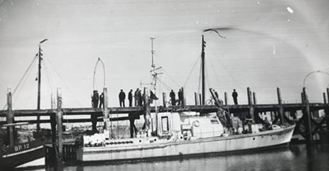Sponsors
National Historic Ships UK acknowledges the financial support of its sponsors
About Ship Happens
Ship Happens is a family project started by the Robins family. Simon and Gemma bought MV Sarinda, an ML1392 World War Two warship, in January 2021. Their aspiration is to restore her and make her seaworthy again in time to cross the channel as part of the D-Day celebrations, joining the flotilla led by HMS Medusa (ML 1387). Simon and Gemma Robins run a RV conversion company, Creation Campers, near Wrexham, Wales. They have undertaken previous boat restorations of inland waterways craft, however this is their largest project to date. They have the help of their two children, Mason and Emilia, who are very involved with the project.
During the Covid-19 lockdown, the YouTube channel 'Ship Happens' was set up as a means of keeping family members informed as to the progress of the project. Unexpectedly, the group gained recognition and now has over 33k subscribers from over 30 countries worldwide. The videos have generated over 1.8 million views as of the end of June 2021. In addition, the project has been featured in newspaper and articles in the UK, USA and Europe together with a television appearance on Chicago News – WGN TV.

History of MV Sarinda
The harbour defence motor launch (HDML) was a 72 ft (22m) long British-designed motor vessel used for harbour defence during World War II. Records show that 464 were built by numerous Allied countries worldwide during the war and saw service in Europe, the Far East and Australasia. The HDML was designed by W J Holt at the Admiralty in early 1939. ML 1392 was built by Berthon Boat Lymington and was completed on 20 December 1943.
As part of the 149th ML Flotilla, she was a navigation leader at Gold Beach during the D-day landings in June 1944 identifying the start of safe passageways through minefields. The HDML’s wooden construction and shallow draft made them ideally suited to sit on or in the vicinity of minefields. On 6 March 1945, she captured a Biber-type German midget submarine off Breskens in the Scheldt estuary.
In October 1947, she was transferred to HM Customs & Excise and renamed Valiant. In about 1967, she was sold and became the motor yacht Frol-Pejo. By 1974, she had been renamed Sarinda and has been identified offering day cruises from Liverpool. A total rebuild as a luxury motor yacht was started in 1979 and completed by a new owner after she was sold in 1987. She was subsequently sold to the current owners who are undertaking a sympathetic restoration.

Restoration
There are three distinct areas for restoration. The original hull needs to be made watertight and renewed as necessary. The work on replacement ribs has started using appropriate resources such as oak timber and copper nails, however, both products are expensive thus necessitating a significant early budget pressure. The key task is to make the ship watertight with a view to remove her to dry land to enable easier access and make it possible to paint the hull below the waterline.
Secondly, works undertaken during the 1970s and 1980s above the deck bulwarks were not carried out with suitable materials – marine ply was not used and substantial areas have had to be stripped out or made temporarily watertight with tarpaulins or plastic sheeting. The ravages of being left in the open have taken their toll on the infrastructure. The decks need fully replacing, and they aim to get this done before winter to help keep the rain out causing further damage.
Finally, the navigation, communications, interior fittings, the galley and general furniture need to be identified, prioritised and installed. The overarching element of the project is to paint or revarnish the whole ship externally and internally. Where possible improvements will be carried out on a like for like basis.


Funding
The magnitude of the project has not been lost on the owners and they acknowledge that this will require their commitment, both financial and in time, over several years. The initial works will be funded from their own resources although a small group of supporters have provided disparate items ranging from tools to food and even a kettle. A recent copper nail fundraising drive was a success and further small-scale funding opportunities may be undertaken.
Part of the YouTube offer is the provision of a shop with branded merchandise and items such as mugs, car stickers and clothing. Additionally, the “Buy Me A Coffee” concept has been used successfully whereby supporters purchase a virtual cup of coffee for £3. A sponsor has currently been brought on board for the provision of paint and other sponsors are being actively sought.
Finally, an organisation called Patreon facilitates a funding method for supporters to pay a small monthly fee in return for benefits such as early release of weekly videos and Patreon only short films. There are currently about 130 Patreons. Family members – parents and children – have assisted in routine tasks but the main technical restoration work is being undertaken by the owners. The first volunteer trial for exterior painting took place in July 2021.
All of the above may give the impression that funding and people have been successfully found – this is not the case. The copper nails and timber covered just 20% of the amount needed, let alone the costs relating to the infrastructure and equipment. A regular labour force of two adults and two children is inadequate, especially as there is a business to run to fund the works, let alone any time needed for rest and recuperation.
To support Ship Happens and follow their journey subscribe to their YouTube channel and follow them on Facebook.

National Historic Ships UK acknowledges the financial support of its sponsors